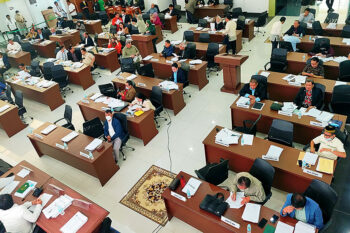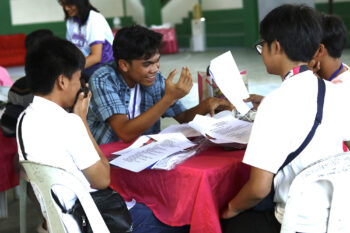CAGAYAN DE ORO CITY (MindaNews/02 October)—“Revolutions happen in quiet places.” This was a popular mantra printed on posters in the 1960s, the decade of fiery activism here and abroad. Plastered on walls in work places and dormitories of activists and “street parliamentarians,” this ubiquitous poster reflected the mood of the times as that decade wore on.
It was the decade that saw the rise of protest movements in the world’s capitals,. And that was when our own youth learned to attend or conduct teach-ins, seminars, and workshops, at first in discreet corners of their neighborhood or in the suburbs, then in the heart of campuses as their advocacy became more and more militant.
And it did come to pass that what started out as quiet exchanges and sessions analyzing socio-political problems turned into revolutionary fervor and a resolve to work for reforms. Resolutions and manifestos would be issued left and right by placard-bearing advocates whose marches became commonplace in metropolitan areas.
Thus was a societal ferment for change and reform stirred up in the halls of academe, inflaming the rank and file of studentry. It simmered, frothed, and picked up force, accelerating till it erupted during the First Quarter of 1970 to protest the corrupt elections that gave Ferdinand Marcos an unprecedented second term.
The revolutionary mood raged on through the decade of the 70s and into the 80s, gaining strength even more from the fall of Ninoy in August 1983. It refused to die, and it found expression in nightly noise barrages and subtle protests, increasingly bolder at home and abroad. Ultimately, it forced Marcos into agreeing to hold Snap Elections—which of course led to the Edsa People Power Revolution.
When the Conjugal Dictatorship finally decamped in February 1986, “People Power” entered the dictionary as our unique contribution to lexicography. It was a worthy counterbalance to “domestic worker” which came to define “Filipino” as a result of Marcos’s policy of pushing our brethren into serfdom abroad for the precious remittances he needed to prop up our failing economy.
Rise of People Power
After Edsa, it dawned in the minds of many that in fact People Power had always been with us, but that it worked in unspectacular ways. They recalled that its stirrings had been foreshadowed in such terms as “popular participation” and “community organizing” that were in vogue in activist circles years before. Moreover, they realized that it did not necessarily involve massing on streets or “inciting to rebellion”—as some did and others do.
It also occurred to them that there is People Power whenever groups, small or large, meet to address an issue—to draft a position paper, write a resolution, hold a group discussion, conduct a teach-in, or write a letter to the editor.
At other times they recognized People Power in action when advocacy groups made use of public service segments in broadcast stations, when funds were pooled to buy advertising space on media, or when citizens volunteered to serve in task forces and study groups.
They saw it at work too when citizens demanded public hearings on controversial issues or testified in them. And it was manifested when people invested in socially meaningful ventures such as the Gawad Kalinga program or Habitat for Humanity.
Such are the elements of a quiet revolution. Unspectacular social action, really.
Some are routine activities in the course of business or profession. Unfortunately, there are many who think it unnecessary to engage in essential affirmative acts that greatly impact on the community, such as taking part in its governing processes. They figure that they already have lobbies, connections, and influence in high places—something the poor don’t have.
So the poor or lower classes are left to themselves with no connections or influence in high places, feeling powerless.
This powerlessness drives them to play along with political and economic predators that coddle and manipulate them for political gain. As a result, because of their sheer numbers they overpower the views and votes of the elite—who don’t bother to speak out or show up in the commons.
The presence and the voice of the middle and upper classes, without whose backing or support no revolution can succeed, are the missing element needed for the success of a quiet revolution in the community or barangay—which is the level of the grassroots, the primal base of our Republic.
It’s not enough to replace Corrupt Leaders
Unfortunately for the elite and the elitists who claim to want reforms, they don’t seem to know that voice and visibility are important for the reform movement. Nor that anyone with a yen to straighten out politics, arrest graft and corruption, or neutralize abuse, need not look beyond his own community.
All political chicanery and the insidious schemes of trapos are played out in the barangay’s neighborhoods. The problems of governance start there and stay unless responsible residents next door do something about them.
The trick is to know what brings about corruption and bad governance: how it starts in the neighborhood and spreads, how it spirals upwards, how it trickles back down, how the cycle goes on and on, and why only the community can break the cycle.
Actually people already know the causes of corruption and bad governance but either ignore them or prefer to do other things. Mostly they think nothing can be fixed except in a spectacular way such as through another Edsa uprising or through a coup or revolution.
But they’re wrong. We’ve had two Edsa upheavals and all we accomplished was replace Ferdinand Marcos and Joseph Estrada while the national condition continued to worsen.
Simply replacing the one in power with another who’s eager to be in power doesn’t solve the problem. The motive for being in power would still be the same; the way to the top would still require guns, gold, goons, or “Hello, Garci….”
Ultimately the officeholder would still dictate the conduct of governance, not the Rule of Law nor the will of the people.
Bottom line, the people would still be powerless, bypassed or taken for granted, unable to influence governance. And the system becomes a mere caricature of democracy.
Strictly speaking, there’s no way to stop graft and corruption for good. Like sin, it may be prevented momentarily or minimized but there is no guarantee that the sinner will not sin again. The transgressors are human, after all. They are endowed with free will and freedom to do what they like for whatever motive, good or bad.
How else can it be? Like everyone, they are subject to temptation, and some people are simply incorrigible. They are the reason why we build prisons — to punish wrongdoing after the fact, hoping it will reform them as well as deter others.
But it is a measure of our society’s values that we fill the prisons with petty criminals but let Big-Time plunderers stay out to enjoy their loot.
But even though there’s little one can do about the motives or the ethical sense of traditional politicians—trapos— there’s a lot sovereign people can do to inhibit wrongdoing, arrest their corrupt acts, and reform the way they behave. It just requires the judicious, relentless application of People Power and vigilance in their own community, whence originate all cultural values and traditions. Try straightening out governance in your own barangay and see how fairly easy it is. (MindaViews is the opinion section of MindaNews. Manny Valdehuesa writes from Cagayan de Oro and is the president and national convenor of Gising Barangay Movement Inc. He can be reached at valdehuesa@gmail.com.)







